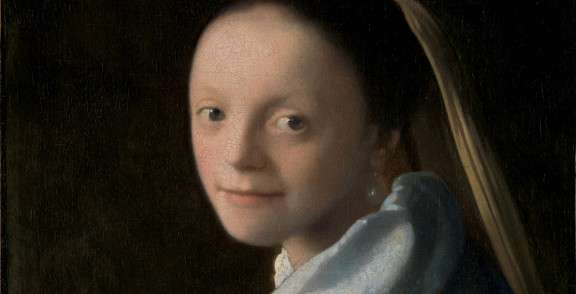Lapis Lazuli

Young Woman with a Water Pitcher
Johannes Vermeer
c. 1662–1665
Oil on canvas, 45.7 x 40.6 cm.
Metropolitan Museum of Art, New York
Vermeer, like many painters of his time, made do with a very limited palette consisting of approximately ten to twelve pigments. The only substantial difference between his and the palettes of his contemporaries was a preference for genuine ultramarine (pure lapis lazuli imported from Afghanistan) rather than the more common and cheaper azurite.
Genuine ultramarine is made of the powder of the crushed semi-precious stone lapis lazuli which is thoroughly purified by repeated washings and bound to a drying oil (walnut, linseed or poppy oil) through hand-mulling. The exact proportions between pigment and vehicle (natural drying oil, usually walnut oil) and the correct amount of mulling necessary to produce the highest quality paint can only be acquired by experience. Even when the process is mastered, the resulting paint possesses a tenacious, stringy quality which makes it difficult to brush out evenly. However, when mixed with lead white this defect is greatly mitigated.
Pure, natural ultramarine paint is a very deep transparent blue. Compared to other pigments on the artist's palette, it is very dark; only black is darker. Mixed with lead white, it maintains its brilliance even in the palest shades. The superior cost, complicated preparation, and poor brushing qualities of genuine ultramarine are offset by its exceptional brilliance and mixability. Today, genuine ultramarine blue is still being produced by a handful of specialized firms although it has been largely replaced by synthetically produced ultramarine blue, which for all practical purposes, is equal, if not superior to the natural product in every aspect.
A fine example of genuine ultramarine can be seen in the satin morning jacket of Woman in Blue Reading a Letter, which is again fully appreciable after the recent restoration of the painting. The gem-like depth of the wrap in The Milkmaid provides another. In the latter case, the excellent state of conservation of the painting allows us to appreciate in full the chromatic brilliance of pure lapis lazuli. Although genuine ultramarine can be found in almost every painting by Vermeer, it is truly surprising to what extent he actually employed the pigment. Not only is it found in blue colored objects, but upon close inspection, traces of it can be found in white drapery, black marble tiles, green foliage, white washed walls and even in the shadows of the orange satin gown in The Glass of Wine.
Vermeer's penchant for genuine ultramarine seems to have reached an almost obsessive degree unless we understand the artist's exceptional sensitivity to optical phenomena. He realized early in his career that the mixing of genuine ultramarine with shades of gray, usually composed of lead white, bone black and raw umber in varying proportions, lends the luminosity characteristic coolness of intense daylight which cannot be attained otherwise. Mixtures of blue in the shadows of objects would be employed systematically many years later by the French impressionists.
An excellent example of Vermeer's use of genuine ultramarine can be found in Young Woman with a Water Pitcher. Obviously, genuine ultramarine was used to paint the folded blue drapery on the table but it was also used to render the incoming daylight that filters through the translucent panes of glass. Observed with care, we can see that even the dark gray lead molding has been lightly over painted with lapis lazuli. The contrast between the bluish tone of the glass and the warm tones of the wooden window frame produces an absolutely natural effect.
The linen head dress worn by the young woman was initially modeled in shades of white and a light neutral gray. Once dry, the artist superimposed pale shades of genuine ultramarine (admixed with lead white) over the shadows to render the transparency of the starched cloth inundated by sunlight. Genuine ultramarine has even been detected in the light gray paint of the background wall.





 or anything else that isn't working as it should be, I'd love to hear it! Please write me at:
or anything else that isn't working as it should be, I'd love to hear it! Please write me at: